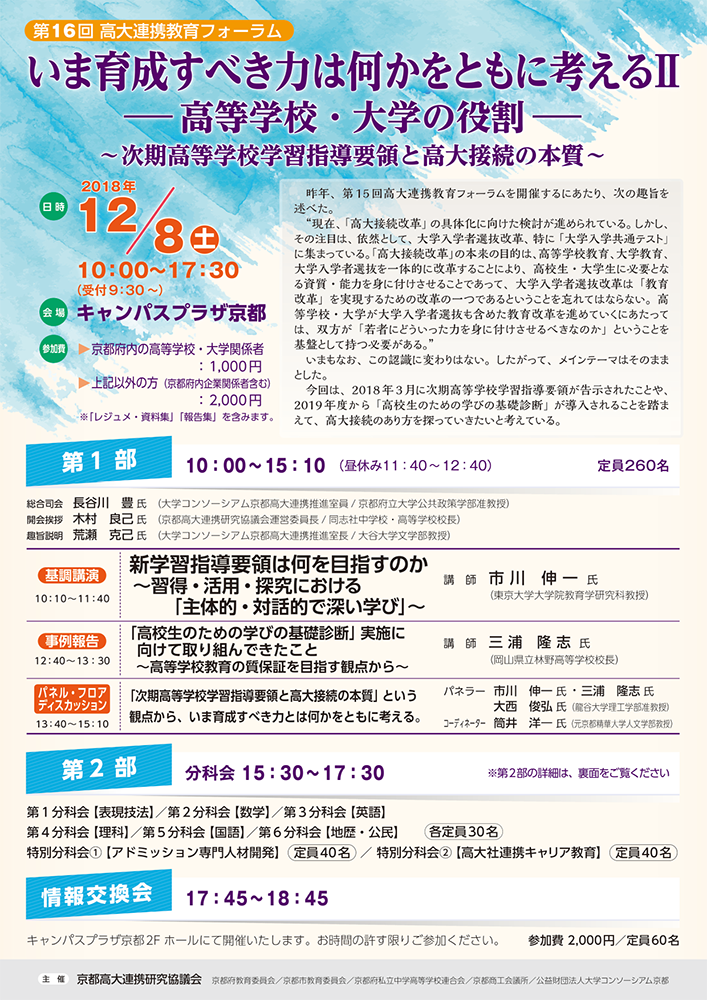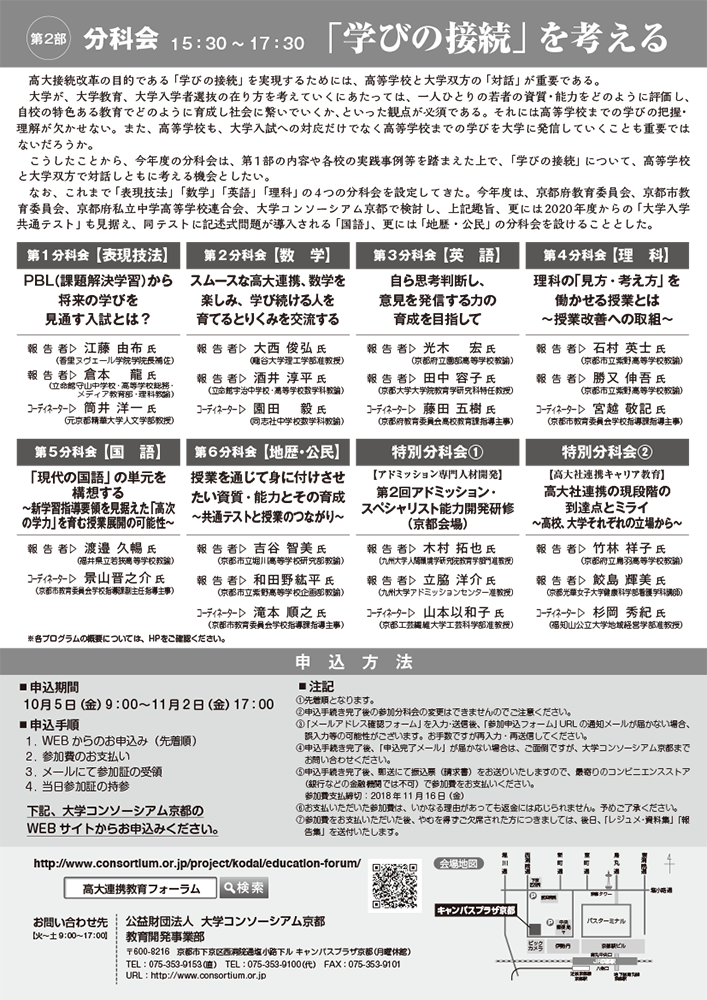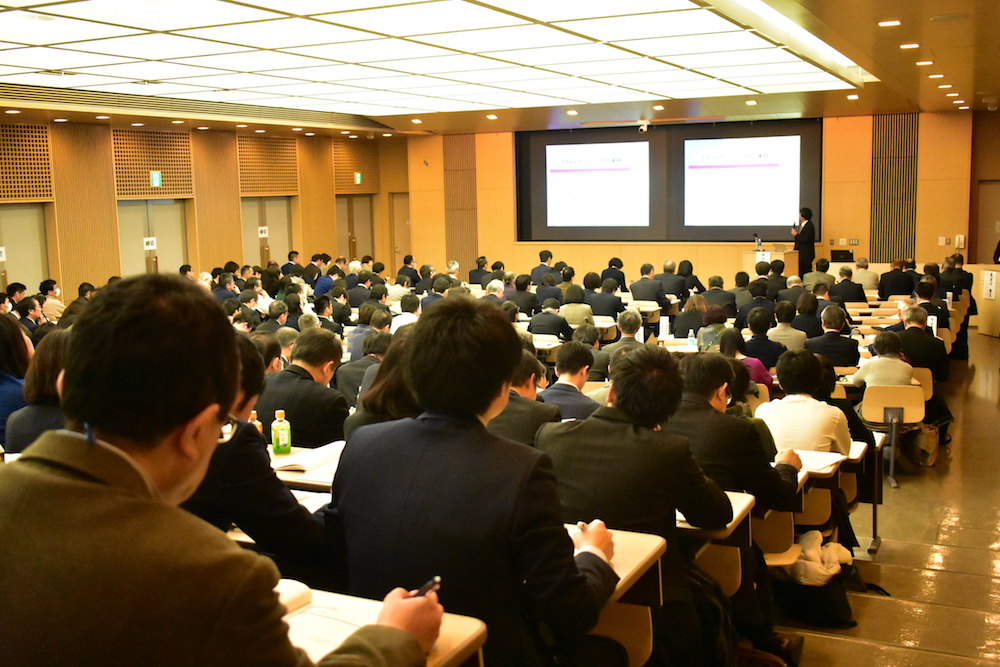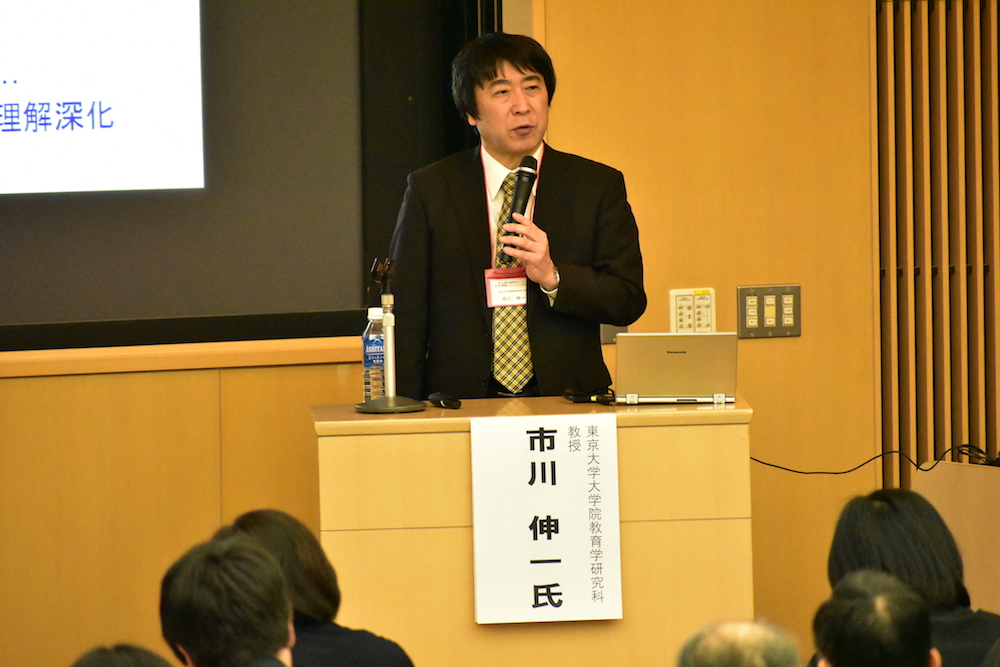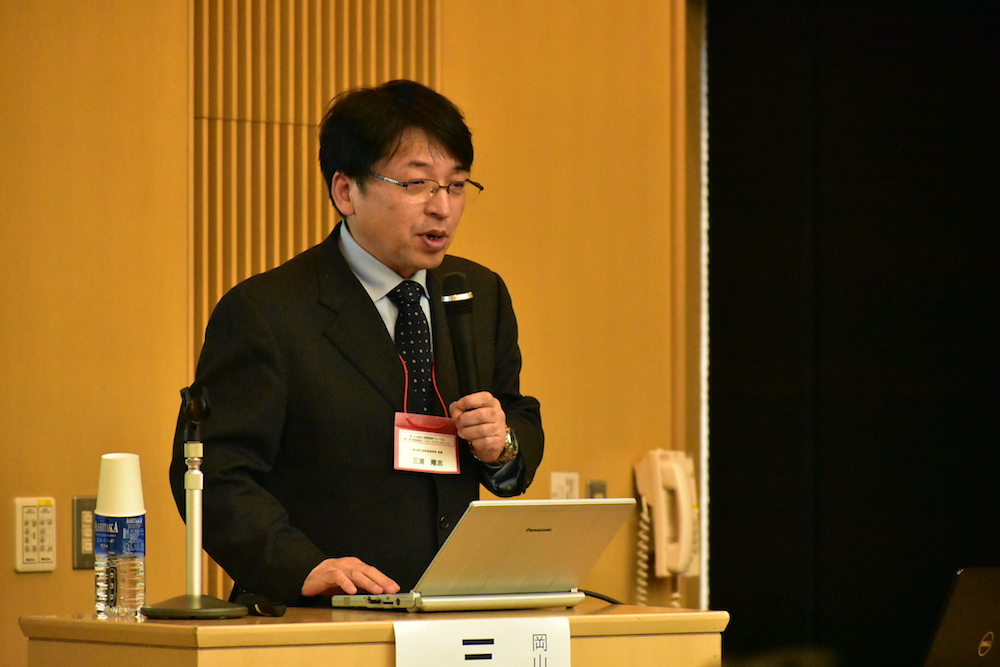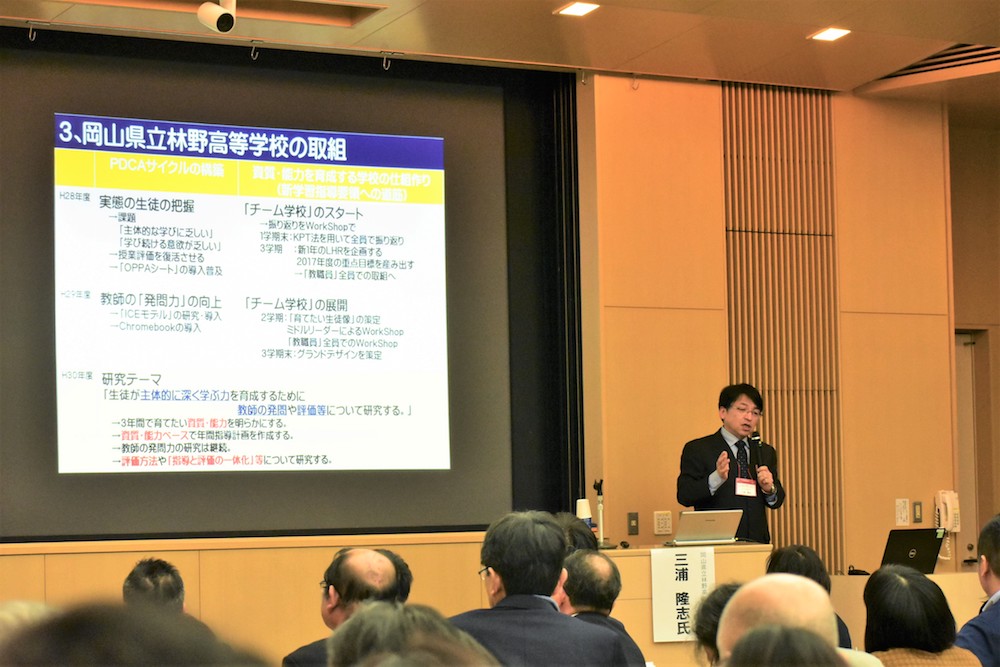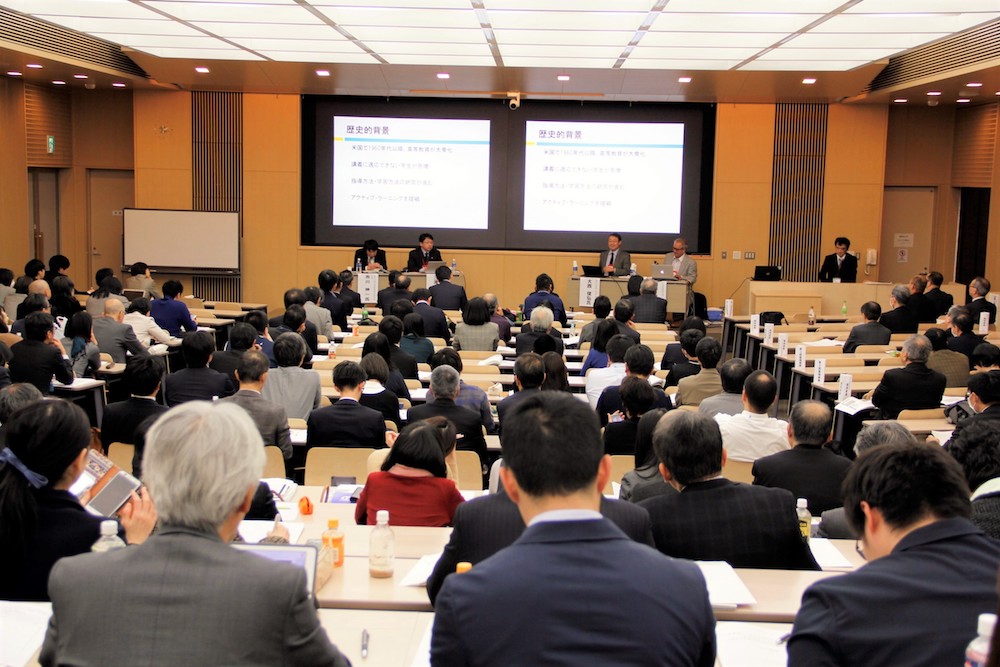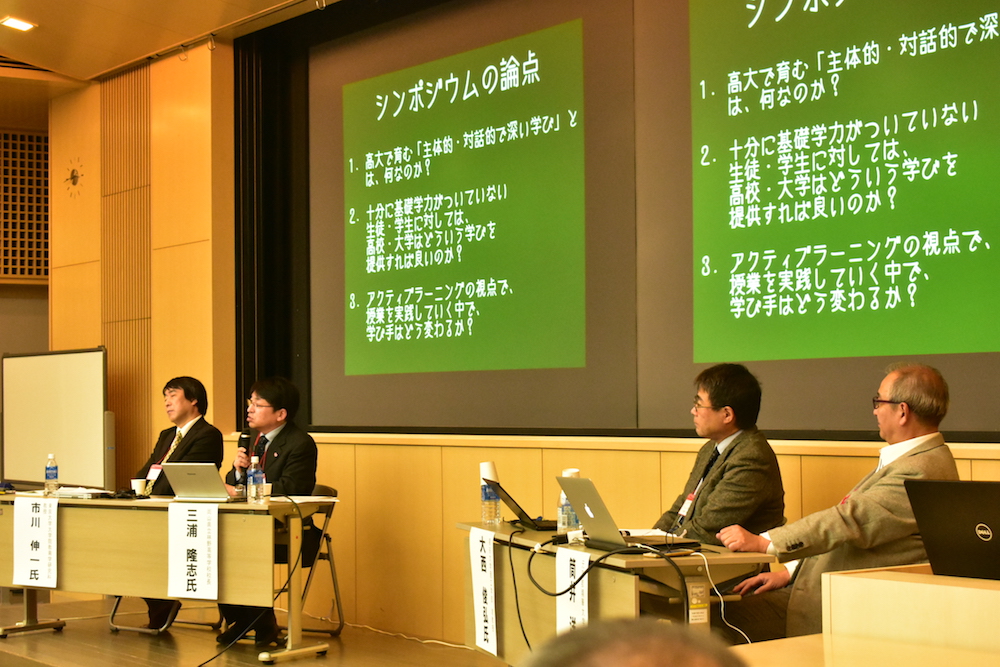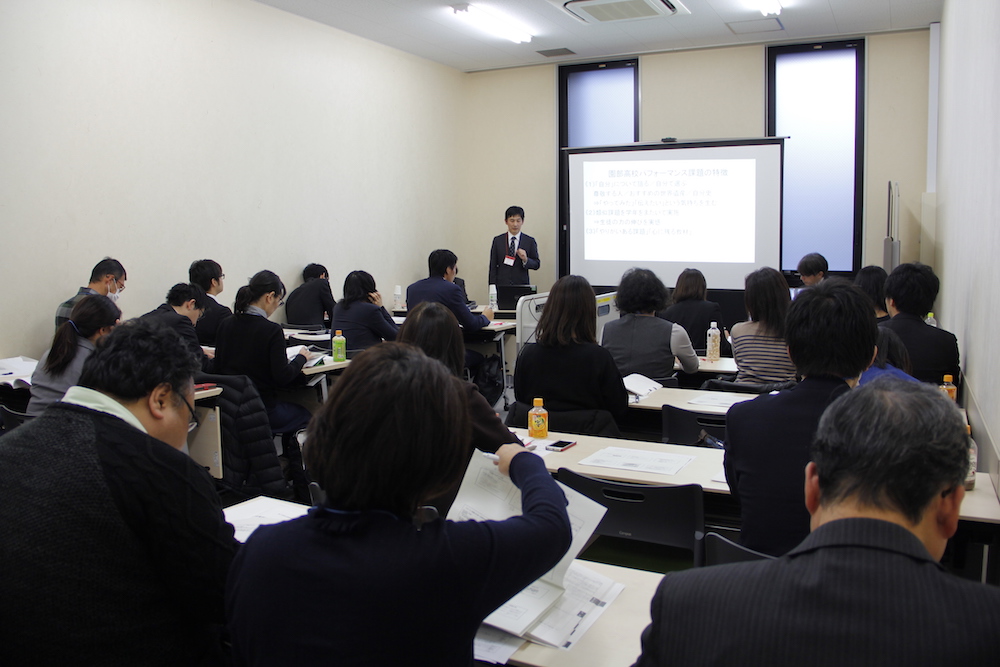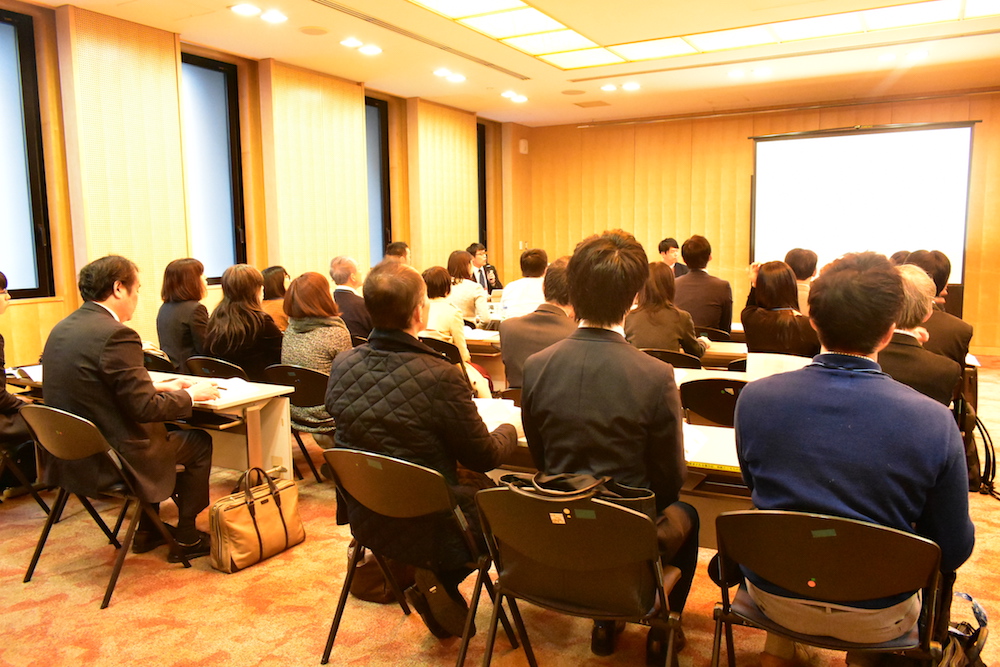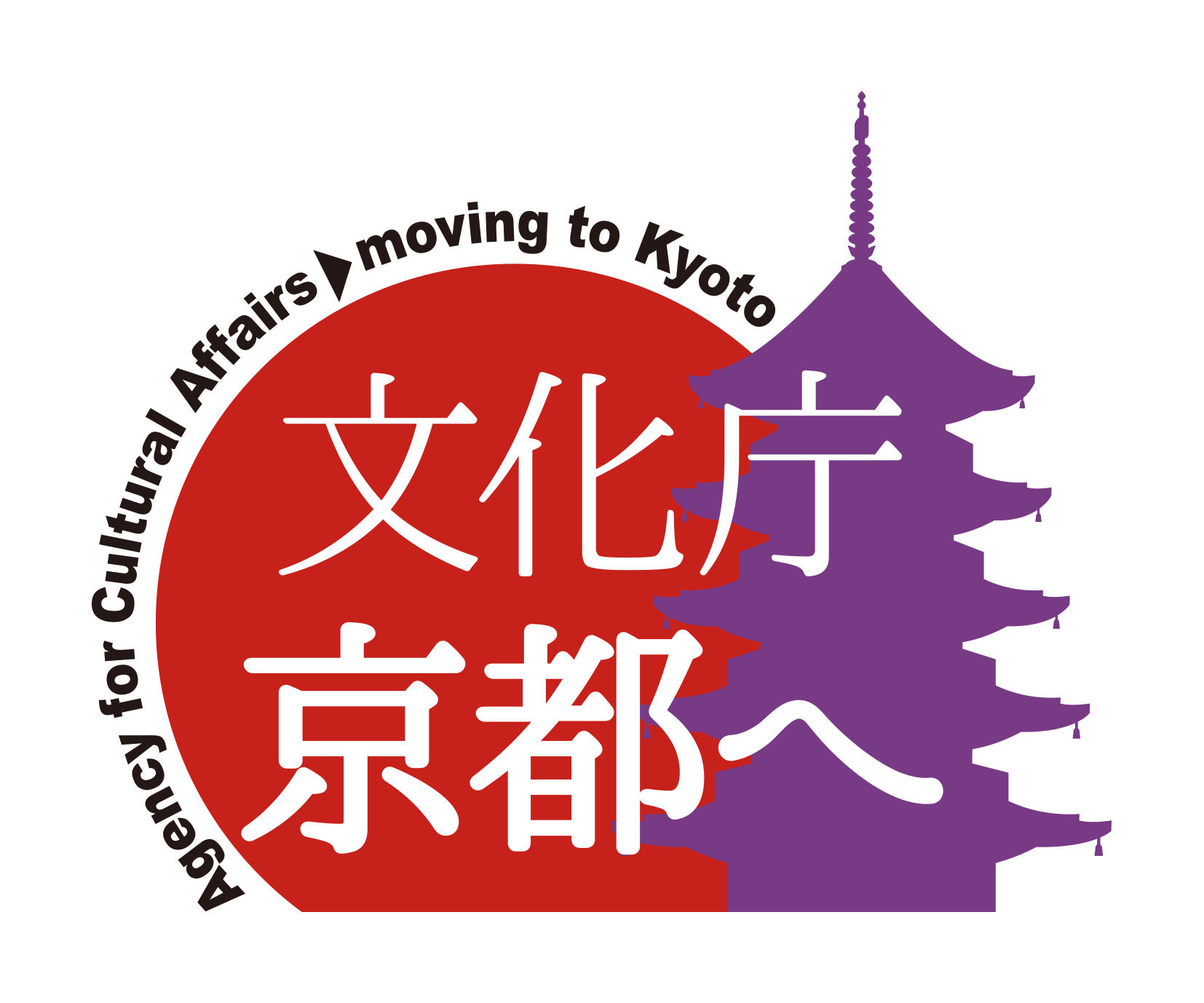Business Overview
The forum is held for the purpose of “sharing information on domestic trends and disseminating information on initiatives in Kyoto” in the issue of collaboration and connection education between high schools and universities.
Outline of the event
The 16th High School-University Collaborative Education Forum
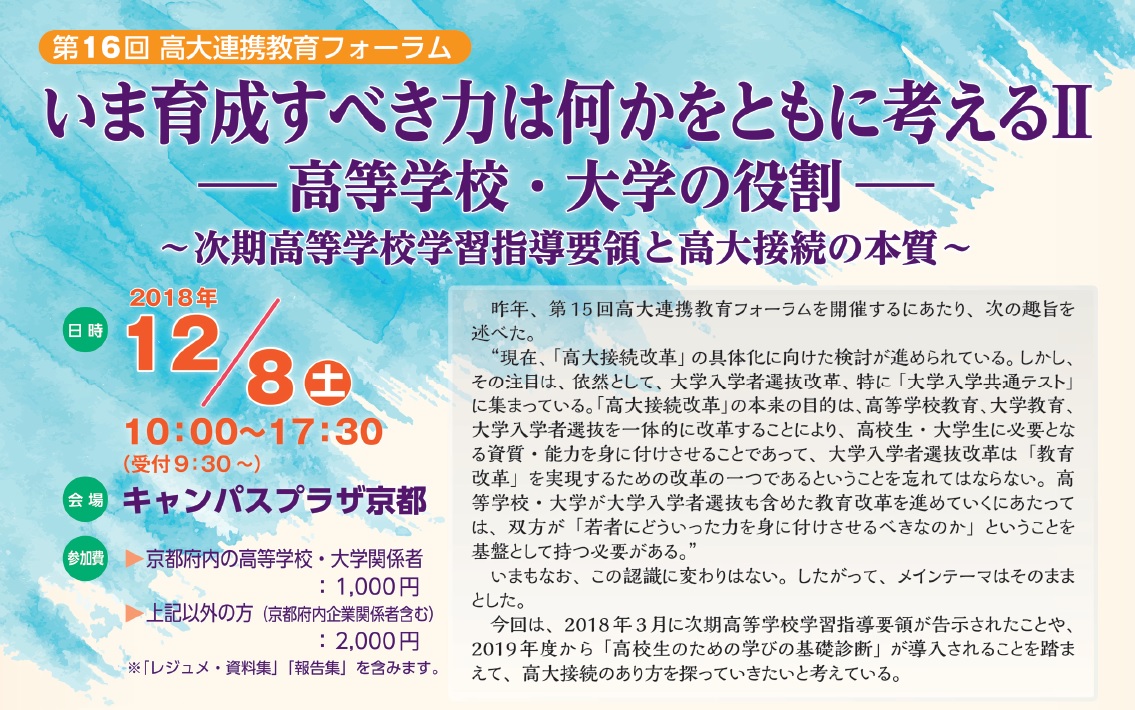
* The capacity has been increased.
| Date: | Saturday, December 8, 2018 | ||
| Venue: | Campus Plaza Kyoto | ||
| theme | Thinking Together about the Abilities That Should Be Developed Now II: The Role of High Schools and Universities ~The Next High School Course of Study and the Essence of the High School-University Connection~ |
||
| decide Part |
1: | Keynote speeches, case reports, panel and floor discussions | : 300 (first-come, first-served basis) |
| Part 2 | Subcommittee “Expression Techniques” 40 | people (first-come, first-served basis) * Increased | |
| Breakout Sessions: Mathematics, English, and Science: | 30 each (first-come, first-served basis) | ||
| Subcommittee “Japanese Language” | 50 members (first-come, first-served basis) * Increased number of members | ||
| Subcommittee “Geography and Civics” 35 | members (first-come, first-served basis) *Increased number of members | ||
| Special Subcommittee (1) “Development of Admissions Specialists” | 40 (first-come, first-served basis) | ||
| Special Subcommittee (2) “Career Education for High School and University Collaboration” 50 | (first-come, first-served basis) * Increased number of employees | ||
| Information exchange meeting: | 60 people (first-come, first-served basis) | ||
| three increase Expenses |
Part 1 & Part 2 | High schools and universities in Kyoto Prefecture Persons other than the above (including participants of companies in Kyoto Prefecture) * Includes “Resume / Material Collection” and “Report Collection”. |
JPY 1,000 JPY 2,000 |
| If | you are participating in the information exchange meeting held at the Campus Plaza Kyoto Hall, please pay the right amount in advance. | JPY 2,000 | |
| Organizer: | Kyoto High School-University Collaborative Research Council (Kyoto Prefectural Board of Education, Kyoto City Board of Education, Kyoto Prefectural Federation of Private Junior and Senior High Schools, Kyoto Chamber of Commerce and Industry, University Consortium Kyoto) | ||
You can download the flyer for the 16th High School-University Collaborative Education Forum here.
【Part 1】10:00~15:10 Keynote Speech, Case Reports, Panel and Floor Discussion
General Chairperson
Yutaka Hasegawa (Member, Kyoto High School University Collaboration Promotion Office, University Consortium / Associate Professor, Faculty of Public Policy, Kyoto Prefectural University)
Opening Remarks
Mr. Yoshimi Kimura (Chairperson of the Kyoto High School-University Collaborative Research Council / Principal of Doshisha Junior and Senior High School)
Explanation of purpose
Dr. Katsumi Arase (Director, Kyoto High School University Collaboration Promotion Office, University Consortium / Professor, Faculty of Letters, Otani University)
| Keynote Speeches 10:10~11:40 |
What does the new course of study aim for? ~”Proactive, interactive, and deep learning” in acquisition, utilization, and inquiry~
|
| We will talk about the fact that “proactive, interactive, and deep learning” is not only for inquiry-based learning, and that by incorporating it in acquisition classes, it is possible to effectively improve the teaching and scientific skills necessary for entrance exams, using examples from OKJ (teaching and making students think) and learning method courses. | |
| 11:40~12:40 | Lunch break |
| Case Reports 12:40~13:30 |
What we have been working on to implement the “Basic Diagnosis of Learning for High School Students” ~From the perspective of ensuring the quality of high school education~
|
| For three years from the 28th academic year, our school has been designated by the Ministry of Education, Culture, Sports, Science and Technology as a “Survey and Research Project for Learning Improvement for the Establishment of Basic Academic Skills of High School Students” and has been engaged in research practice. This research project is not limited to the implementation of a new “basic diagnosis of learning,” but has been conducting comprehensive research and practice on what kind of “academic ability” should be acquired in front of the students in front of them in high school, and how to send them out to higher education such as universities and society, in succession from elementary and junior high schools. In this forum, we will report on the school’s efforts so far and its future prospects. | |
| Panel & Floor Discussion 13:40~15:10 |
From the perspective of “the next high school course of study and the essence of the high school-university connection,” we will consider together what kind of skills should be cultivated now.
|
【Part 2】15:30~17:30 Breakout Session “Connecting Learning”
In order to realize the “connection of learning,” which is the purpose of the reform of the high school-university connection, it is important to have a “dialogue” between both high schools and universities.
When universities consider university education and the selection of university admissions, it is essential to consider how to evaluate the qualities and abilities of each young person, how to nurture them through their own unique education, and how to connect them to society. In order to achieve this, it is essential to grasp and understand what students have learned up to high school. In addition, it is important for high schools not only to respond to university entrance exams, but also to disseminate to universities what they have learned up to high school.
For this reason, we would like to use this year’s subcommittee as an opportunity for both high schools and universities to engage in dialogue and think together about the “connection of learning” based on the contents of Part 1 and practical examples from each school.
So far, four subcommittees have been set up: “Expression Techniques,” “Mathematics,” “English,” and “Science.” This year, the Kyoto Prefectural Board of Education, the Kyoto City Board of Education, the Kyoto Prefectural Federation of Private Junior and Senior High Schools, and the University Consortium Kyoto have examined the above, and in anticipation of the above objectives, as well as the “Common Test for University Admissions” from the 2020 academic year, it was decided to establish subcommittees on “Japanese language” and “Geography and Civics” in which written questions will be introduced into the test.
| Session 1 [Expression technique] |
What is the entrance examination that predicts future learning from PBL (problem-solving learning)?
|
| In the future of education, it is necessary to have the ability and practice to identify issues and questions for the future on their own. Two presenters who are engaged in inquiry-based learning in high school education will introduce an example, and in the end, the participants will discuss in group work what kind of entrance examination and education they want to implement. | |
| Session 2 [Mathematics] |
Smooth high school-university collaboration, exchanging efforts to nurture people who enjoy mathematics and continue to learn
|
| We will work to smoothly connect students from high school to university learning, and to exchange ideas and ingenuity to nurture people who continue to be interested in mathematics and continue learning. | |
| Subcommittee 3 [English] |
Aiming to cultivate the ability to think and judge for oneself and express opinions
|
| In this subcommittee, based on the performance issues that Kyoto Prefectural Sonobe High School is working on based on the theory of backward design and the practical report of performance evaluation based on the rubric, we will define how to develop the ability to think and judge for oneself and communicate one’s own thoughts in the new course of study, and exchange opinions with the participants. | |
| Session 4 [Science] |
What is a class that uses the “way of seeing and thinking” of science? ~Initiatives to Improve Classes~
|
| In order to “aim to further reliably cultivate the qualities and abilities that students will have to carve out for the future society” required by the new Course of Study, it is necessary to improve classes in high schools from the perspectives of “independent learning,” “interactive learning,” and “deep learning.” In this subcommittee, the presenter will propose what it means to use the “way of seeing and thinking” of the subject, which is the key to “deep learning,” and discuss it with the participants. | |
| Subcommittee 5 [Japanese] |
Envisioning a Unit on the Modern Language ~Possibility of developing classes that foster “higher academic ability” in anticipation of the new course of study~
|
| In the new Course of Study, the common compulsory subjects will be reorganized into “Modern Japanese Language” and “Language and Culture.” What kind of class improvements can be made from now on, keeping an eye on the philosophy of the new subject structure of the Japanese Language Department, the goals of each subject, and the qualities and abilities to be developed in each subject? We will explore the possibility of this by proposing a lesson plan for “modern Japanese language” that aims to foster “higher academic ability.” In addition, I would like to exchange opinions not only on measures for the “new test” but also on how to approach the reform of the high school-university connection. | |
| Session 6 【History/Civics】 |
Qualities and abilities that you want to acquire through classes and their development ~The connection between standardized tests and classes~
|
| Each teacher is making daily efforts to improve classes by realizing proactive, interactive, and deep learning by having students engage in classes while applying the social perspectives and ways of thinking indicated in the new Course of Study, and to develop the ability to think, make judgments, and express themselves. In the course of analyzing the questions that are more characteristic of the Common Test for University Admissions, we will report on examples of class practices aimed at fostering the qualities and abilities that high school students should acquire, and discuss specific ways to improve classes. | |
| Special Breakout Session (1) 【Recruitment Specialist Development】 |
The 2nd Admissions Specialist Capacity Development Training (Kyoto)
|
| Continuing from last year, this special subcommittee will give lectures on the knowledge and evaluation methods required for the development of highly specialized human resources in the field of high school-university connection. This program is intended for university and high school faculty and staff who are in charge of entrance examinations and career paths. This subcommittee will be jointly held with the Center for Educational Development at Kyushu University Next Generation University. Lecture 1 (Mr. Kimura’s Lecture Theme: Creating an Admission Questionnaire) Lecture 2 (Lecture Theme: Support for Students with Disabilities in University Entrance Examinations) |
|
| Special Breakout Session (2) 【High School and University Collaborative Career Education】 |
The Achievement of the Current Stage of High School and University Collaboration and the Future ~From the standpoint of high school and university~
|
| There are few examples of collaboration between high schools and universities, and they are still in the early stages of their efforts. Therefore, at present, it is necessary to accumulate case studies, confirm the achievements and challenges at the current stage from the verification, and envision the future of Mirai. Therefore, this year, we will first take up two examples of high school-university collaboration, and we will ask them to provide topics about the latest initiatives from the standpoint of high schools and universities. In the second half, I would like to have a three-dimensional discussion involving the participants. |
Information Exchange Meetings
| 17:45~18:45Information | exchange meeting will be held in the hall of Campus Plaza Kyoto, which will be the venue of this forum. Snacks and beverages will be available, so we encourage you to join us. |
Application
If you would like to participate, please contact the High School-University Collaborative Education Forum.
(E-mail: kodai@consortium.or.jp/TEL: 075-353-9153)
Step 1
Please register your e-mail address from the “Apply” button below.
Step 2
Please access the URL of the “Application Form” sent to your registered email address, enter it according to the instructions on the screen, and receive the “Application Completion Email”.
Step 3
Please pay the participation fee at a convenience store by Friday, November 16, 2018 using the payment slip and invoice that will be mailed to you.
Step 4
Please receive a “Participation Certificate” sent to your registered email address.
Step 5
On the day of the forum, please bring your “Participation Certificate” and present it at the reception.
Application period: Friday, October 5, 2018 9:00 a.m. ~ Friday, November 2, 2018 5:00 p.m.
* If you do not set cookies in your browser to “Enabled”, you may not be able to apply.
* Each subcommittee has a fixed number of members, so it cannot be changed after the application procedure is completed.
* Reception is not available on the day of the event.
Implementation Report
The 16th Forum on Collaborative High School-University Education Report [Click here for details]
Continuing from last year, the main theme of the event was “Thinking together about the skills that should be developed now: The role of high schools and universities,” and this year’s event was “The Next Course of Study for High Schools and the Essence of the High School-University Connection.” Approximately 300 people participated, far exceeding the initial number of applicants, and the first part of the event was held at two venues, the main venue and the video and audio distribution venue.
In the keynote speech, Professor Shinichi Ichikawa of the Graduate School of Education, the University of Tokyo, gave a lecture titled “What is the goal of the Course of Study ~’Proactive, interactive, and deep learning’ in acquisition, utilization, and inquiry~”.
In the afternoon, as a case report, Mr. Takashi Miura, Principal of Okayama Prefectural Hayashino High School, took the stage and reported on “What we have been working on to implement the ‘Basic Diagnosis of Learning for High School Students’ ~From the perspective of aiming for quality assurance of high school education~”.
In the panel and floor discussion, Professor Ichikawa, Principal Miura, and Associate Professor Toshihiro Onishi of the Consortium of Kyoto High School and University Collaboration Promotion Office / Faculty of Science and Engineering, Ryukoku University joined the panel, and Professor Yoichi Tsutsui, former professor of the Faculty of Humanities at Kyoto Seika University / Professor Yoichi Tsutsui, a former professor of the Faculty of Humanities at Kyoto Seika University, served as the coordinator. We had a discussion together.
In addition, the participants deepened their discussions while exchanging opinions in groups of high school and university students.
In the second subcommittee, the participants were divided into eight subcommittees: “Expression Techniques,” “Mathematics,” “English,” and “Science,” with the addition of “Japanese Language” and “Geography and Civics,” as well as “Recruitment Specialist Human Resource Development” and “Career Education in Collaboration with High School and University,” and information was shared and opinions were actively exchanged on each theme.
Many people also participated in the information exchange meeting after the breakout session, and it was a place for information exchange, including the speakers and reflections among the participants.
Inquiries
University Consortium Kyoto High School-University Collaborative Education Forum
TEL 075-353-9153 FAX 075-353-9101
〒600-8216 Shimogyo-ku, Kyoto-shi, Nishitoin-dori, Shiokoji, Shimo-ku, Kyoto, Campus Plaza Kyoto
* Reception hours: Tuesday ~ Saturday 9:00 ~ 17:00 (excluding year-end and New Year holidays)














